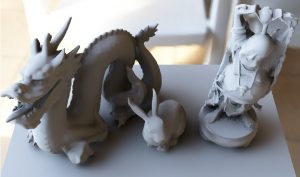Prof. Dr. Arnulph Fuhrmann
Arnulph Fuhrmann ist Professor für Computergrafik an der TH Köln und leitet die Computer Graphics Group.

Arnulph Fuhrmann ist Professor für Computergrafik an der TH Köln und leitet die Computer Graphics Group.
Inhalt Die Veranstaltung wird von Prof. Krüger und Prof. Fuhrmann…

In this paper, a remote rendering system for an AR app based on Unity is presented. The system was implemented for an edge server, which is located within the network of the mobile network operator.

This paper investigates the effects of normal mapping on the perception of geometric depth between stereoscopic and non-stereoscopic views.

We investigate the influence of four different audio representations on visually induced self-motion (vection). Our study followed the hypothesis, that the feeling of visually induced vection can be increased by audio sources while lowering negative feelings such as visually induced motion sickness.

Um die Attraktivität des Antizipations- und Reaktionstrainings für jugendliche Torwarte zu erhöhen war es das Ziel eine sportartspezifische Umgebung in virtueller Realität (VR) zu entwickeln.

The ability to localize a device or user precisely within a known space, would allow many use cases on the context of location-based augmented reality. We propose a localization service based on sparse visual information using ARCore, a state-of-the-art augmented reality platform for mobile devices.

In this work, we acquired a set of precisely and spectrally resolved ground truth data. It consists of the precise description of a new developed reference scene including isotropic BRDFs of 24 color patches, as well as the reference measurements of all patches under 13 different angles inside the reference scene.

We present a new, physically plausible, real-time approach to compute directional occlusion for dynamic objects, lit with image based
lighting.

In this paper, we present SIAM-C, an avatar-mediated communication platform to study socially immersive interaction in virtual environments.
The following paper investigates the effect on the intensity of perceived vection by changing the field of view (FOV) using a headmounted
display (HMD) in a virtual environment (VE).
Recent advances in real-time rendering enable virtual production pipelines in a broad range of industries. These pipelines are based on a fast, latency-free handling in addition to the accurate appearance of results. This requires the use of high dynamic range rendering for photo-realistic results and a tone mapping operator for a matched display.

ANT steht für Augmented Reality Navigation Tool und ist eine Ergänzung des Personenleitsystems im Bereich des Instituts für Medien- und Phototechnik (IMP) am Campus Deutz der TH Köln.
We describe an experimental method to investigate the effects of reduced social information and behavioral channels in immersive virtual environments with full-body avatar embodiment.

Diese Masterthesis beschäftigt sich mit der bildbasierten Rekonstruktion und Vermessung von dreidimensionalen Objekten mit Hilfe einer Smartphone Applikation